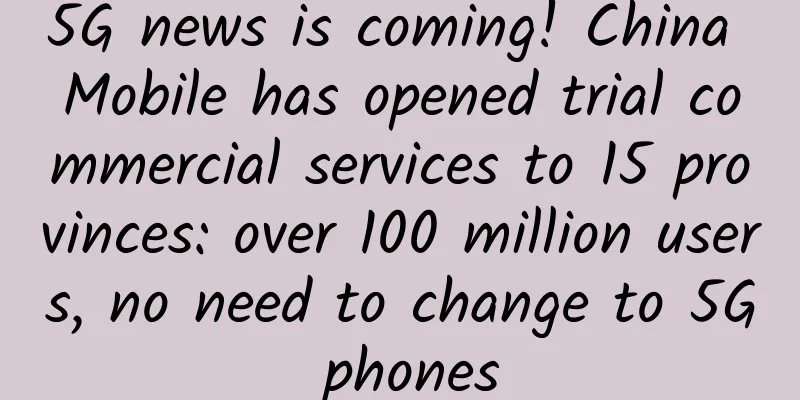The 5G competition between China and the United States is heating up. What will the future hold?

|
As we all know, 5G has become the main battlefield for technological competition among major countries. Whoever has the upper hand will have the initiative in future technology. The influence of 5G also lies in the fact that 5G empowers related industries and promotes tens of trillions of output value in related industries such as artificial intelligence, the Internet of Things, the Industrial Internet, big data, and cloud computing.
I will not comment on the policies of various governments here, but will only analyze this century-long battle in the field of science and technology from a technical perspective. What will be the future trend? 1. Current status of the network People in China who have been to the United States, or those who have lived in the United States for a long time and occasionally return to China, have this experience: the same mobile phone often freezes in the United States, but it is much smoother in China. In China, you can use your mobile phone to shop online, play online games, watch Douyin, and read headlines anytime and anywhere, even on a high-speed train with a speed of 350 kilometers per hour, but it is difficult in the United States. Why? Take a look at the data below to understand. In 2019, the total number of 4G base stations in China was 5.44 million, while the number in the United States was only 400,000, which is less than a fraction of that in China. The total number of 4G base stations is less than 1/13 of that in China, and the number per capita is less than 1/3 of that in China. Not only is the number of 4G equipment in the United States small, but also, because of the government's exclusion of Chinese equipment manufacturers and insufficient competition, Chinese manufacturers' high-quality and low-cost equipment are excluded. It is conceivable that such a network must be much worse than that in China. Why talk about 4G first when talking about 5G? It is impossible to build a high-rise building on flat ground. The 5G network will always be built together with 4G first, and then independently. It can be said that 4G will have to operate normally for a long time. In particular, because the frequency of 5G is much higher than that of 4G, the loss is much greater than that of 4G, and indoor coverage may still rely on 4G for a long time. Therefore, the quantity and quality of the existing 4G network determine how fast and how well 5G will develop in the future. Conclusion: China’s current wireless communication network is much better than that of the United States. 2. Spectrum Resources Regarding 5G spectrum resources, China's 5G was the first to use the FR1 band: 450MHz-6GHz, also known as the Sub-6GHz band, also known as centimeter wave; however, because the Sub-6GHz band in the United States has long been occupied by the military, 5G can only use the FR2 band: 24.25GHz-52.6GHz, also known as millimeter wave (mmWave). The biggest problem with the millimeter wave band compared to the centimeter wave band is that the loss is much greater, requiring closer base station deployment and greater investment. Troubled by funding, the United States is still hesitant and has not yet built 5G on a large scale. The latest news is that on February 28, the US FCC voted to pass a plan: to use $9.7 billion to buy back the FR1 frequency band used by satellite companies and re-auction it to telecommunications companies for 5G network construction. China's Sub-6GHz frequency band division was completed in 2018 and officially put into commercial use in October 2019. According to the Ministry of Industry and Information Technology of China, by the end of 2019, China had opened 130,000 5G base stations across the country. It is estimated that at least 680,000 base stations will be built in 2020. By the end of 2020, all prefecture-level cities in China will be covered by 5G networks. The United States originally planned to build 50,000 new 5G base stations in 2020. This gap seems to be getting bigger and bigger. Therefore, in terms of spectrum resources, China is obviously superior to the United States. 3. Communication standards In the 1G era, the United States was the pioneer of analog communications and had the final say; in the 2G era, Europe's GSM and the United States' CDMA were evenly matched; in the 3G era, Europe's WCDMA, the United States' CDMA2000, and China's TD-SCDMA were the three major standards; in the 4G era, it was mainly Europe's FDD-LTE and China's TD-LTE, and WiMAX, developed by the Americans themselves, soon withdrew from the stage of history; in the 5G era, unified standards were adopted, with China's Huawei and the United States' Qualcomm as the main participants, and Chinese manufacturers dominated the 5G standards. It can be seen that from 1G to 5G, the United States' voice in the field of communication standards has become increasingly weak. China has gradually taken control of communication standards, from TD-SCDMA in the 3G era to TD-LTE in the 4G era and then to 5G. At the same time, Chinese companies such as Huawei, ZTE and China Mobile have more and more patents. 4. Communication equipment Let’s first briefly review the ups and downs of wireless communication equipment manufacturers over the past 20 years. In the 1G era, Motorola of the United States dominated the market, and there was a lack of Chinese equipment manufacturers. In the 2G era, Europe gave birth to communication giants such as Ericsson, Nokia, and Alcatel, while the United States' Motorola gradually lost its former glory, and China's Huawei and ZTE were in a follower position. In the 3G era, China's Huawei and ZTE rose rapidly and shared the same market share with European manufacturers. In the United States, only Qualcomm sold chips and collected patent fees. In the 4G era, Chinese manufacturers, especially Huawei, have taken a leading position and their market share has further expanded. At the same time, European manufacturers have declined. Alcatel was sold to Nokia, and Qualcomm still relies on chips and patents. In the 5G era, Chinese manufacturers have surpassed others in all aspects, while European manufacturers continue to decline. On February 20, Huawei announced at the 5G New Product and Solution Launch Conference in London that Huawei's 5G products and solutions are 12-18 months ahead of its peers. In my opinion, this is not an exaggeration. The 5G network is very complex. It not only has a wireless access network (mainly including base stations and base station controllers, etc.), but also a transmission network, core network, etc. Huawei is not only ahead of its peers in wireless access, but also in transmission network and core network. The transmission network is mainly an optical network. 5G large-capacity, high-speed data is mainly transmitted through optical fibers. Huawei's optical chips have reached 800G, while the most advanced in the industry can only reach 400G, and the average is 100G. Huawei's optical transmission has entered a no-man's land many years ago. Lucent and Nortel, which were once famous in the field of optical transmission, were completely defeated many years ago and are now almost extinct. In addition, Huawei's microwave transmission is also the world's number one. In the core network part, for many years, Cisco's high-end routers and core switches have dominated the high-end market. After the rise of Huawei, Cisco's market share has become smaller and smaller, especially in China, where it has shrunk rapidly. Cisco has been laying off employees continuously in recent years. See the above figure, the 2019 telecom market share of major equipment vendors released by Dell'Oro Group of the United States on March 3. Except for China's Huawei and ZTE, which are still listed, the others are declining. Huawei's share is far ahead, and it is still rising. On March 4, Omdia, an international authoritative research organization, released the 2019 Global Router Market Share Report, which shows that Huawei's router products rank first in the global operator market share. Not long ago, there were reports that the US government was planning to invest in Ericsson and Nokia, or to let Cisco integrate Ericsson and Nokia, in order to counter China. Regardless of whether European countries are willing to follow the US's wishes, even if they agree, looking at the picture above, Cisco + Ericsson + Nokia, which are all on the decline, should not be able to compete with Huawei + ZTE, which are on the rise. Moreover, Huawei is not only leading in individual products, but also has a complete ecosystem and strong competitiveness. Therefore, in terms of communication equipment, there is still a big gap between the United States and China. 5. Application 5G cannot develop rapidly if it only has network coverage but no applications. Thanks to China's continuous and massive investment in manpower and capital in the field of mobile communications over the past decade, mobile Internet has developed rapidly and penetrated rapidly in China. my country already has the largest number of 4G users in the world. By the end of 2019, the total number of 4G users reached 1.28 billion. The popularity of 4G smartphones has promoted the explosive development of mobile Internet, and mobile payment, online shopping, online games, and various application apps are flourishing. The rapid coverage of 5G networks, coupled with domestic consumption upgrades, will promote faster development of mobile Internet. The United States' 4G network is not as good as China's, its population base is not as large as China's, and it lags behind China in mobile payments and online shopping. In the 5G era, mobile Internet applications will also lag behind China. In addition to mobile Internet, 5G applications also include the broader Internet of Things and Industrial Internet. 5G's Internet of Things applications have been very useful in this fight against the epidemic. Remote diagnosis, remote B-ultrasound, remote surgery, unmanned nursing, unmanned disinfection, unmanned delivery, etc., are all enabled by 5G. The industrial Internet application of 5G is even more of a blue ocean. China is a manufacturing powerhouse with a complete range of industries and a large number of industrial enterprises. There are strong and diverse demands for the application of the industrial Internet. 5G will empower industrial manufacturing and enable my country to transform from a manufacturing power to a manufacturing powerhouse. I believe that after the epidemic, with the huge investment in new infrastructure, 5G+artificial intelligence+Internet of Things+Industrial Internet+Big Data will promote the rapid deployment of 5G, while the application of 5G will advance in breadth and depth, complementing each other. Therefore, China is expected to continue to lead the United States in the application of 5G. Through the above analysis, in the Sino-US 5G competition, China is basically ahead of the United States, and it is very difficult for the United States to turn the tables! Once the trend of history is formed, the obstruction of a small number of people will only bring some interference, but it is impossible to stop the general trend of history. The rejuvenation of the Chinese nation is unstoppable! |
>>: The need for SD-WAN in a multi-cloud world
Recommend
HostYun: Hong Kong EPYC series 1~2Gbps bandwidth three-network BGP optimization monthly payment starting from 23.8 yuan
HostYun launched the internal test of the Hong Ko...
"Prevention" is the key! The three major operators have taken multiple measures to help resume production and work
With the end of the extended Spring Festival holi...
A graphic guide to selecting network equipment
Hello everyone, I am Xiao Fu. Illustrated network...
Maker Beijing 2020 Kunpeng Application Innovation Special Competition briefing session to answer questions and enhance contestants' awareness of the competition!
At 2:30 pm on July 28, 2020, the Maker Beijing 20...
You’ll regret it if you don’t read it: Web design tips to improve website conversion rate
[51CTO.com Quick Translation] There is no doubt t...
The days of exponential growth in 5G capex are over, but the outlook is not bleak
Stefan Pongratz, vice president and analyst at ma...
DediPath: $49/month-E3 1270/16GB/2TB/1G unlimited traffic/5IP/Los Angeles data center
[ Promotion code expired ] Title This should be th...
Top 7 web scraping tools for 2019
The Internet is constantly flooded with new infor...
2G network withdrawal encounters new resistance, and most of the existing IoT is based on 2G network
Currently, operators are actively migrating 2G us...
With ten times storage cost savings, SINO ADM helps enterprises reduce costs and increase efficiency
Preface The COVID-19 pandemic has had an unpreced...
5G era: Will WiFi disappear from people’s lives?
WiFi has gradually penetrated into our daily live...
Four factors driving 100Gbps network upgrades
According to Crehan Research, 100Gbps and 25Gbps ...
Priced from 4999 yuan, Huawei Mate40 series goes on sale in China today
On October 30, 2020, in Shanghai, the highly anti...
China's five major mobile app stores jointly launch 64-bit Android ecosystem migration
(April 19, 2021) In order to assist Chinese Andro...
What is the role of NB-IoT in 5G networks?
Exploring the role of narrowband IoT in 5G networ...


![[11.11] LOCVPS: 30% off on all VPSs/50% off on some VPSs, 50 yuan bonus for 300 yuan top-up, KVM/XEN multiple computer rooms available](/upload/images/67cac23c1c8be.webp)






